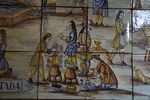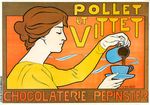Chocolate: Glorify or Demonize? - A bittersweet look at this most commonly craved food - Sylvia R. Karasu, MD
←
→
Page content transcription
If your browser does not render page correctly, please read the page content below
4/17/2018 Chocolate: Glorify or Demonize? | Psychology Today
Sylvia R. Karasu M.D.
The Gravity of Weight
Chocolate: Glorify or Demonize?
A bittersweet look at this most commonly craved food.
Posted Apr 13, 2018
Willy Wonka tells the children who are fortunate enough to tour his factory, in
Roald Dahl’s classic Charlie and the Chocolate Factory, that he has
"Supervitamin Chocolate” that contains all the vitamins from A to Z ("except for
vitamin S, which makes you sick, and vitamin H, which makes you grow horns")
and the most magical vitamin of them all—vitamin Wonka.” Clearly Willy Wonka
has manufactured his own fantasied concoctions, but what do we know about
the origins of chocolate, how it is made, and whether it is as healthy as some An 1896 Art Nouveau poster for the
hot chocolate drink from Pepinster in
would have us believe?
Belgium.
Source: Alamy/used with permission
Cultivation of the cocoa bean originated in
Mesoamerica, possibly 1000 years BC, (Rusconi and Conti, Pharmacological
Research, 2010), and was used later by both the Mayan and Aztec civilizations.
According to one myth, cocoa came from the blood of an Aztec princess, who
chose to die rather than betray her kingdom's wealth. (Gianfredi et al, Nutrition,
2018) In another, it was discovered by the gods in the mountains. (Dillinger et
al, Journal of Nutrition, Supplement, 2000.)
A Mayan lord with a container of
One of the first Europeans to mention a bitter drink made from the cocoa bean
frothed chocolate. Ancient Mayan
texts describe cocoa as having a was Hernando Cortés, who landed on the eastern area of Mexico and
divine origin.
described how Aztec emperor Montezuma used it as an aphrodisiac. (Dillinger
Source: Wikimedia Commons/Public
Domain et al, 2000; Lippi, Nutrition, 2009) It was the Swedish naturalist Linnaeus, in
1753, who used a Mayan word in his scientific description and called cocoa,
Theobroma cacao, "Food of the gods." This early Mayan drink was made by dissolving dried cocoa beans in
water with cinnamon and pepper. (Verna, Malaysian Journal of Pathology, 2013). Others described cocoa as
having "as much nourishment as a pound of beef" (Quélus, 1719) or even that it was a "universal medicine,"
(Lavedan, 1796) which was literally used to treat hundreds of ailments, from wasting diseases to hypochondria
and even hemorrhoids. (see Dillinger et al, 2000)
Though anecdotal evidence of the healing powers of cocoa has existed for
centuries, it was not until later in the 20th century that researchers appreciated
that cocoa beans are one of the richest sources of polyphenols, which are
antioxidants that trap dangerous free radicals in the body and prevent them
from destroying cells and tissue. (Oracz et al, 2015, Critical Reviews in Food
Science and Nutrition.) Cocoa beans, whether fresh or processed, contain
Typical 17th century scene that
more polyphenols (and give the beans their bitter, pungent taste) than coffee,
demonstrates the preparation of
black or green tea, or wine. Flavonoids, the largest group of polyphenols, are chocolate.(Under the History of
Chocolate in Spain in Wikimedia.
believed to have anti-inflammatory, anti-allergic, and anti-bacterial properties,
Creative Commons Attribution 3.0
among others. (Oracz et al, 2015) Cocoa beans are the seeds of the tree, and unported.)
each seed contains 40 to 50% fat as cocoa butter (Rusconi and Conti, 2010). Source: Wikimedia Commons/Public
Domain
These seeds are"embedded in mucilaginous pulp," within pods that come from
cocoa trees. The trees grow in moist, hot regions in a belt around the Equator.
(Kongor et al, Food Research International, 2016) There are three main varieties of cocoa trees, with the most
common being Forastero. The concentration, though, of polyphenols, depends on the genetics of the bean, but
also environmental conditions, such as soil, sun exposure, rainfall and even storage time. (Oracz et al, 2015)
https://www.psychologytoday.com/us/blog/the-gravity-weight/201804/chocolate-glorify-or-demonize 1/34/17/2018 Chocolate: Glorify or Demonize? | Psychology Today
Today, 70% of our cocoa beans comes from Western and Central Africa, with
Ghana, the primary producer of high-quality cocoa. (Oracz et al, 2015) Cocoa is
a major crop and is grown by 5 to 6 million farmers throughout the world,
(Kongor et al, 2016) with the demand for cocoa growing. There is even a
prediction that by 2020, there may be a world shortage. (Wickramasuriya and
Dunwell, Plant Biotechnology Journal, 2018.)
Cocoa beans, from which our
chocolate products originate, looked Chocolate, from the cocoa bean, is a highly processed substance. Cocoa
like almonds to 16th century liquor, which contains non-fat cocoa solids and cocoa butter, is a paste that
Europeans.
Source: Wikimedia Commons/Public
comes from the bean. Cocoa butter contains both monounsaturated (mostly
Domain oleic acid) and saturated fatty acids (stearic and palmitic). Cocoa powder
results when some of the cocoa butter is extracted from the liquor. Chocolate
is a combination of cocoa liquor, with cocoa butter and added sugar. (Magrone et al, Frontiers in Immunology,
2017) Nibs are cocoa beans without the outer shell. (Di Mattia et al, Frontiers in Immunology, 2017) Milk
chocolate contains not less than 20 to 25% cocoa. (Verna, 2013) White chocolate contains cocoa butter, sugar,
milk powder, and vanilla. (Verna, 2013) When chocolate develops a whitish and opaque "lacy" appearance, there
is nothing wrong with it: part of the cocoa butter has solidified or recrystallized and come to the surface, a
phenomenon known as "chocolate bloom," and can be prevented by storing it in a cool place. (Aguilera, Edible
Structures: The Basic Science of What We Eat, pp. 126-7, 2017)
The processing of chocolate involves many steps. The first, which can take
from 5 to 10 days and reduces the bitterness, is fermentation of the pulp
surrounding the cocoa beans. Next, the beans are sun-dried, following which
they are roasted, which can give the beans their typical color, aroma, and taste
and texture. Then there is conching, in which the beans undergo an agitation
process at high temperatures, and finally, tempering. At every step, there is
considerable loss of the polyphenol content. (Di Mattia et al, 2017) For
example, after 8 days of fermentation, polyphenol levels drop by as much as
58%. (Oracz et al, 2015) For the most thorough general discussion of the
effects of processing on our food supply, see Gyorgy Scrinis' book Nutritionism Chocolate Jar, made in Puebla,
Mexico, ceramic. Gift of Mrs. Robert
(2013), as well as his recent article on ultra-processed foods, (Scrinis and
W. de Forest, 1911.
Monteiro, Public Health Nutrition, 2017.) Source: Metropolitan Museum of Art,
Public Domain
Despite the substantial loss of polyphenols
during the multi-steps involved in processing, cocoa has been touted in recent
years as a food that has almost magical powers. Chocolate, and particularly
dark chocolate, with a cocoa content of at least 70%, has gone from being
blamed for obesity and type II diabetes only a few years ago, to a food that is
considered actually beneficial to health. (Verna, 2013) There are positive
effects even on mood, behavior, and cognition, (Tuenter et al, Planta Medica,
2018) as well as "an extensive range of benefits" on blood pressure, insulin
resistance, cardiovascular disease, and even body weight. (Kord-Varkaneh et
al, Critical Reviews in Food Science and Nutrition, 2018.) The exact
mechanisms for these positive benefits are not completely understood as, for
example, why cocoa decreases platelet aggregation and reduces platelet
adhesion. Cocoa may cause vasodilation of blood vessels by increasing levels
of nitrous oxide, which, in turn, may affect mitochondrial functioning. Increased
Aztec woman pouring chocolate to levels of uric acid, detrimental and painful to those suffering from gout, may
generate foam, circa 1553, from the also have a role here. (Latif, 2013; Ludovici et al, Frontiers in Nutrition, 2017)
Tudela Codex, a pictorial religious
document, now in Madrid, from the Cocoa may also improve the barrier function in the gut by changing the gut's
Aztec culture. microbiome. (Strat et al, Journal of Nutritional Biochemistry, 2016)
Source: Wikimedia Commons/Public
Domain
Scientific investigation, though, on cocoa suffers from many of the same
difficulties as seen in much of nutritional research, and results are often
inconsistent regarding actual benefits. For example, subjects are often not blinded because it is hard to mask
the typical characteristics of chocolate. Further, there are often methodological differences among studies that
https://www.psychologytoday.com/us/blog/the-gravity-weight/201804/chocolate-glorify-or-demonize 2/34/17/2018 Chocolate: Glorify or Demonize? | Psychology Today
make meta-analyses challenging: participants may vary in terms of their BMI,
age, initial health status, and kind of intervention (e.g. what type of cocoa was
used), whether it was in liquid or solid form, or even how long or how much
cocoa was given. Further, when cocoa is mixed with other substances—the so-
called "food matrix"—results may vary. (Elllinger and Stehle, Nutrients, 2016; Di
Mattia et al, 2017) For example, in some but not all studies, the addition of milk
interferes with the absorption of the antioxidants and may negate any potential
health benefits. (Lotito and Frei, Free Radical Biology & Medicine, 2006) Often,
as typical of may nutrition studies, researchers use food frequency (i.e., self-
reporting) questionnaires that can be inaccurate or not even distinguish among
different kinds of chocolate. (Latif, The Journal of Medicine, 2013) Further,
sometimes studies are sponsored by chocolate manufacturers so that conflicts
of interest must, at least, be considered. (Latif, 2013)
Paul Gavarni, "Woman Chocolate
There is, though, a bitter reality to chocolate cultivation, particularly in Western Vendor," between 1855 and 1857,
Walters Art Museum, Baltimore,
Africa in the countries of Ghana and Côte d'Ivoire, where most of the cocoa for Maryland.
the major companies (e.g. Mars, Nestlé, Cadbury, Hershey) comes. Apparently, Source: Wikimedia Commons/Public
Domain
because cocoa farmers live in poverty, they have exploited children, often
resorting to overt slavery, to maintain
competitive prices. (Food Empowerment Project, Chocolate Industry, 2014)
Conditions for many of these children are unsanitary and unsafe: at least until
recently, most are not allowed to attend school. They are fed poorly, work from
sunrise to sunset, climb the high cocoa trees, cut the cocoa bean pods with a
machete, and are exposed to toxic chemicals used to control insect infestation
and disease. One report noted that "virtually" all children have scars all over
their bodies from accidents with the machetes. Rarely, if ever, have these
children even tasted any chocolate products. (Food Empowerment Project,
2014). For a discussion of some recent attempts to protect these children and
mandate school attendance, see the article in Fortune Magazine by Brian
Jean-Étienne Liotard (1702-1789),
Turkish painter, A "Lady Pouring O'Keefe, March 1, 2016.
Chocolate."
Source: Wikimedia Commons/Public
Domain Bottom line: Throughout the years, chocolate and the cocoa from which it is
made, have been both glorified and demonized. In recent years, cocoa has
been seen as having many health benefits, particularly because of its antioxidants, but study results are not
always consistent. And all researchers acknowledge the dangers to health of overeating highly caloric
chocolate concoctions laden with sugar and other food additives.
About the Author
Sylvia R. Karasu, M.D., is a clinical professor of psychiatry at Weill Cornell Medical College and the senior author
of The Gravity of Weight.
View Author Profile
https://www.psychologytoday.com/us/blog/the-gravity-weight/201804/chocolate-glorify-or-demonize 3/3You can also read

























































